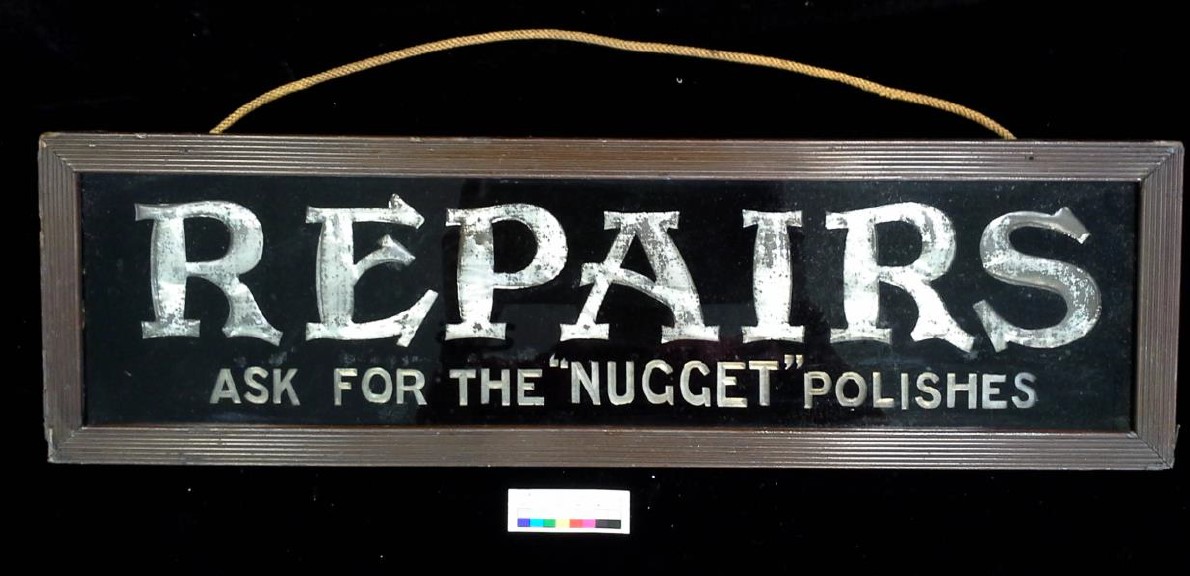July ’21
Nugget Polish Sign
An advertising sign for shoe repairs and Nugget shoe / boot polishing services, which is part of Beamish Museum’s object collection.

Since medieval times dubbin, made from natural wax, oil and tallow, was used to soften and waterproof leather. However, its purpose was not to impart a shine. As leather with a high natural veneer became popular in the 18th century, a high glossy finish became important, particularly on shoes and boots. In most cases, a variety of homemade polishes were used to provide this glossy finish, often with lanolin or beeswax as a base. The first commercial shoe polish was a mixture of sugar, vinegar, black dye and water, but the problem was that this substance came off on peoples clothes.

Prior to 1903, shoe polish was not well known as a purchasable product, nor was it particularly sophisticated. While sales were not especially high, a few brands, like Nugget, were available in England during the 1800s. The practice of shining people’s shoes gradually caught on and soon many shoeshine boys in the city streets were offering shoe shines using a basic form of shoe polish along with a polishing cloth.
Whilst a number of older leather preserving products existed, the first shoe polish to resemble the modern varieties (aimed primarily at inducing shine) was Kiwi. Scottish expatriates William Ramsay and Hamilton McKellan began making “boot polish” in a small factory in 1904 in Melbourne, Australia. Their formula was a major improvement on previous brands. It preserved shoe leather, made it shine, and restored colour. (blancoandbull.com)
Condition
- Evidence of dirt on the surface of the object and ingrainded in crevices
- Signs of corrosion on the surface of the metal components
- The varnish on the interior metal component had yellowed and discoloured.
Conservation
The sign was initially deconstructed by removing a number of the metal pins, which held the back in place, so that all of the aspects of the sign could be easily treated.

The glass was surface cleaned using cotton wool swabs with deionised water and a few drops of an appropriate surfactant in order to remove the dirt. Deionised water was found not to affect the glass or paint on the surface and so was deemed appropriate for use. The glass was then cleaned using an appropriate solvent in order to remove the surfactant residue and prevent future deterioration.
The wooden frame was treated with a solution of deionised water and ethanol, which was applied using cotton wool swabs as these were incredibly effective at removing dirt from the crevices on the front of the frame. The wooden backing was gently vacuumed in order to remove any surface dirt.
The iron pins and loops of the frame, which had signs or corrosion on the surface, and which were slightly too small to treat mechanically, were treated with a rust converter in order to stabilise the metal. They were then coated with a Paraloid B-72 solution, which was applied carefully using a paint brush.

The metal strips, which sat immediately behind the glass were treated using a water and ethanol solution in order to remove the yellowed varnish from the surface as this no longer provided an accurate depiction of the signs original look. The corrosion on the reverse of the metal strips was removed mechanically, and then the strips were coated using a Paraloid B72 solution in order to help protect them from future deterioration.
Once the individual components had been treated, the sign was reassembled. In order for the iron strips to be held securely in place, a few new pins needed to be added as some of the original ones weren’t sharp enough to provide sufficient support for the wooden backing.
Stay tuned for next month’s object!
